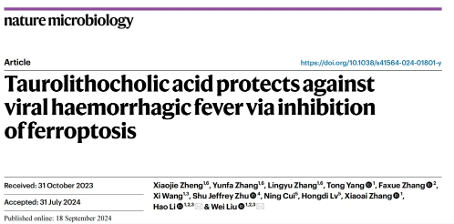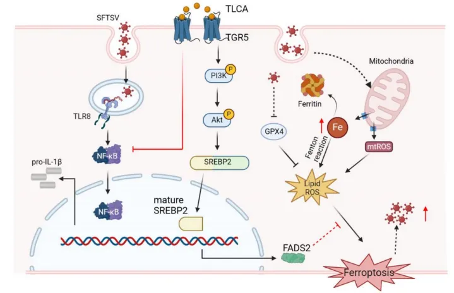Nat Microbiol | Liu Wei/Li Hao reveal new mechanism of bile acid protection against SFTSV (fever with thrombocytopenia syndrome) infection
September 21, 2024
Source: drugdu
 391
391
BioArt September 19, 2024 08:45 Shanghai
Bile acids are metabolites produced by the synergistic effect between the host and its gut microbiota. They can regulate various biological functions and affect the host's susceptibility to viral infections, especially enteroviruses and hepatitis viruses, by activating specific receptors and cellular signaling pathways in intestinal and liver tissues. A small fraction (<10%) of total bile acids can enter the systemic circulation and may play a critical role in antiviral immunity during systemic infections. However, the function and mechanism of bile acids in regulating the host's immune response to viral systemic infections are still poorly understood, and the association between bile acid metabolism and disease outcomes of viral systemic infections is also unclear.
Viral hemorrhagic fever is usually caused by highly pathogenic RNA viruses, which can lead to severe systemic infections, multiple organ failure, and even death. Severe fever with thrombocytopenia syndrome (SFTS) is a newly emerging viral hemorrhagic fever that is prevalent in many Asian countries, with a mortality rate of up to 12% to 50%. The rapid spread of SFTS and the increasing number of human to human transmission events have raised concerns about the potential pandemic of SFTS. Despite its significant clinical and public health implications, the pathogenesis of SFTSV is still unclear, and there are no approved specific treatment methods.
On September 18, 2024, researchers Liu Wei and Li Hao from the Military Medical Research Institute of the Academy of Military Sciences published a study titled "Taurolithocholic acid protection against viral hepatitis fever through inhibition of ferroptosis" in the journal Nature Microbiology. Researchers have found that elevated levels of the secondary bile acid taurocholic acid (TLCA) are positively correlated with low viremia and mortality in patients with SFTS. This further reveals that TLCA upregulates fatty acid desaturase 2 (FADS2) through the TGR5-PI3K/AKT-SREBP2 signaling pathway, inhibiting iron death induced by SFTSV, thereby suppressing virus replication, reducing host inflammatory response, and protecting hosts from fatal infections caused by SFTSV. This study suggests that bile acids have the potential to treat viral hemorrhagic fever. The researchers first reanalyzed the metabolomic data published by the team in Nature Microbiology (2023, 8:91-106) in 2023 and found that low levels of TLCA in the serum of SFTS patients were significantly correlated with hyperviremia, high inflammatory response, and high mortality rate, indicating that TLCA may play a role in inhibiting viral infection and inflammatory response in SFTSV infection.
The researchers first reanalyzed the metabolomic data published by the team in Nature Microbiology (2023, 8:91-106) in 2023 and found that low levels of TLCA in the serum of SFTS patients were significantly correlated with hyperviremia, high inflammatory response, and high mortality rate, indicating that TLCA may play a role in inhibiting viral infection and inflammatory response in SFTSV infection.
The researchers subsequently confirmed at the cellular level that TLCA can significantly inhibit NF - κ B-mediated inflammatory responses through TGR5. Based on transcriptome data of THP-1 cells processed with TLCA, it was found that TLCA may affect SREBPs related pathways and FADS2 expression. Researchers have used techniques such as agonists, inhibitors, and target gene knockdown to confirm that TLCA can upregulate the expression of FADS2 through the TGR5-PI3K/AKT-SREBP2 signaling axis, thereby inhibiting the replication of SFTSV.
Recent studies suggest that FADS2 is an iron death inhibitory factor. To investigate whether FADS2 affects the replication of SFTSV through iron death, researchers first confirmed that SFTSV infection can induce iron death by detecting changes in iron ions, lipid ROS release, iron death related protein expression, and mitochondrial damage, and found that iron death can promote virus replication. Researchers further confirmed at the cellular level and animal models that TLCA can inhibit virus induced ferroptosis by upregulating FADS2, thereby suppressing virus replication and protecting mice from lethal SFTSV infection. In addition, researchers have revealed through the SFTS case cohort that the elevation of serum iron ion and ferritin levels in patients is positively correlated with hyperviremia, and found that serum iron ion and ferritin levels in the early stages of viral infection can accurately predict the occurrence of SFTS mortality outcomes. Figure Molecular mechanism diagram of TLCA inhibiting SFTSV replication by regulating ferroptosis
Figure Molecular mechanism diagram of TLCA inhibiting SFTSV replication by regulating ferroptosis
Researcher Liu Wei and Researcher Li Hao from the Military Medical Research Institute of the Academy of Military Sciences are co corresponding authors of this article. Assistant Researcher Zheng Xiaojie and PhD student Zhang Yunfa and Master's student Zhang Lingyu from the Military Medical Research Institute of the Academy of Military Sciences are co first authors of this article.
Read more on
- CoreMedik Unlocks Dual Certifications for Implantation & Intervention of Artificial Heart December 25, 2025
- First in over 70 years! New drug for schizophrenia approved in China December 25, 2025
- Is the “anti-aging drug” a scientific breakthrough or a capital game? December 25, 2025
- Wegovy oral tablets receive FDA approval, ushering in the “dual-dosage era” for GLP-1 weight-loss drugs December 25, 2025
- The leading medical device company’s new venture is aiming for an IPO! December 25, 2025
your submission has already been received.
OK
Subscribe
Please enter a valid Email address!
Submit
The most relevant industry news & insight will be sent to you every two weeks.



